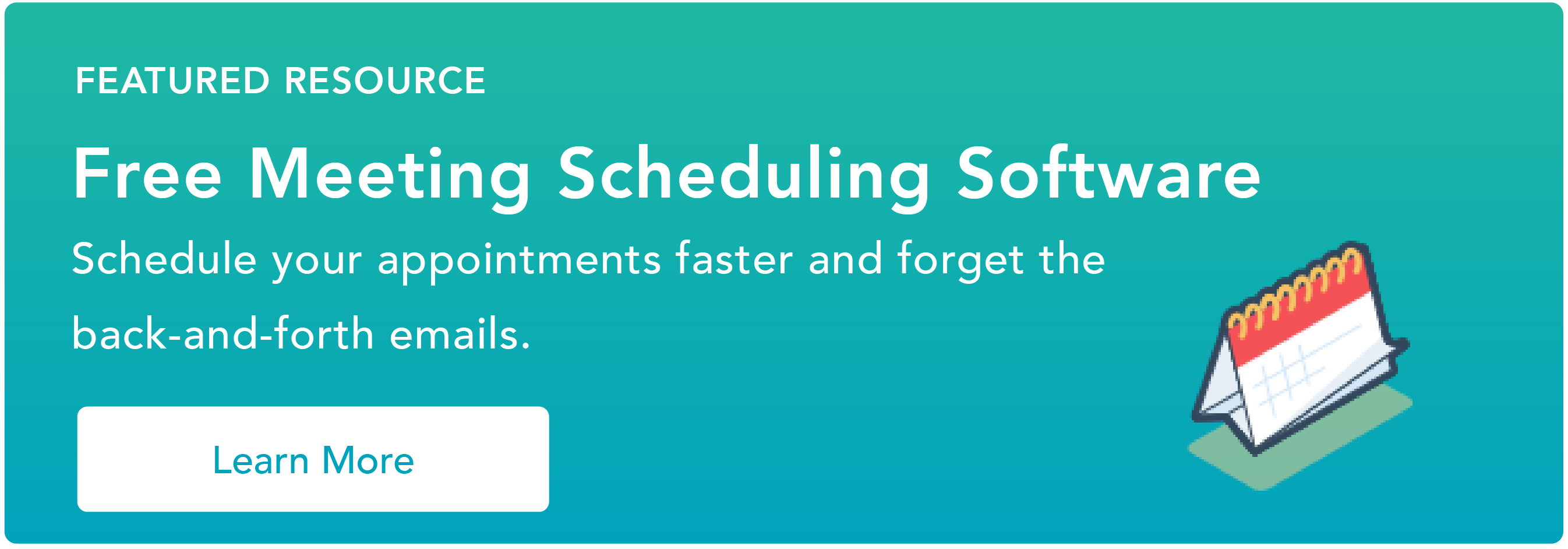Finding a meeting time that works for everyone — an age old dilemma that even the most organized organizer in the history of organizing runs into routinely. Coordinating with prospects, clients, and colleagues to land on a meeting time that's convenient, productive for all parties involved can be time-consuming and grating.

If you‘ve ever been responsible for setting up a meeting involving multiple stakeholders, you’re probably familiar (and frustrated) with this process — so to help make your meeting scheduling as straightforward and seamless as possible, we've put together this handy guide.
Here, we'll cover the basics of finding a meeting time that works for everyone, some best practices for the process, and some tools you can use to ensure you consistently find a time to meet that works for every stakeholder you need to account for.
How to Find a Meeting Time That Works for Everyone
1. Use a meeting scheduling tool.
This is probably the most straightforward, effective way you can approach the whole “When do we meet?” dilemma — solving that problem is literally why these resources were invented, and luckily for you, we have a whole section dedicated to these tools in this article. How neat!
Meeting scheduling tools, like HubSpot's Free Meeting Scheduler, generally include features that cover the bases you need to land on a meeting time that works for every relevant stakeholder you need to meet with.
We‘ll dig a little deeper into those tools, how they work, and the features a lot of them include later in this article, so sit tight. That said, you might be eager to get there — so if you’re getting restless and want to skip all the wonderful insight and information I'm going to offer between then and now, you can click this link to skip ahead.
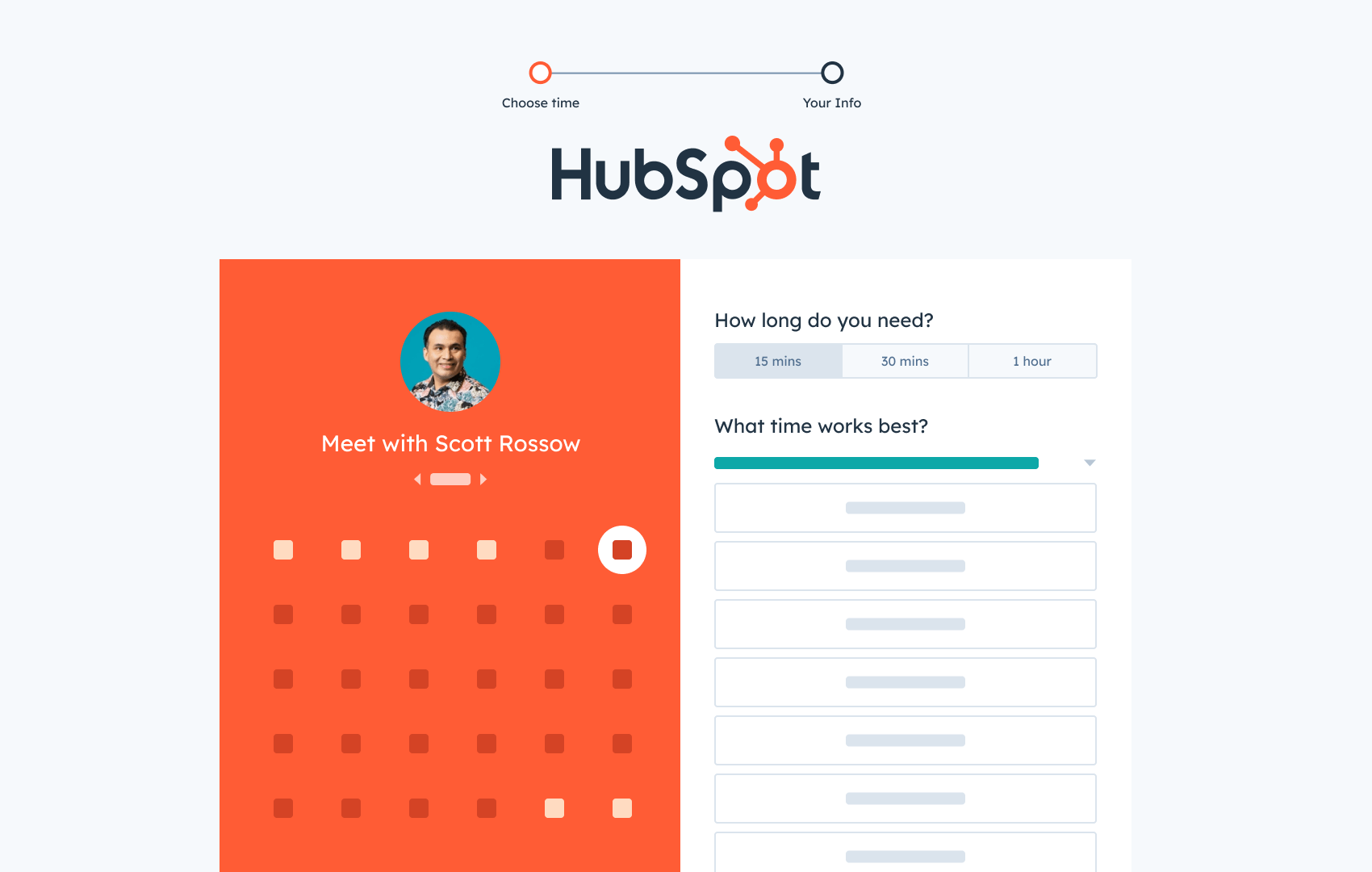
HubSpot's Free Meeting Scheduler
Schedule meetings faster and forget the back-and-forth emails. Your calendar stays full, and you stay productive.
-
Let prospects book a meeting time
-
Book more meetings and appointments
-
Sync with Google and Office 365 Calendar
-
And more!
2. Offer some multiple meeting time options via an email thread.
If you don't want to lean on a meeting scheduling tool, you could always do things the old fashioned way and roll with an email thread. This option should probably be reserved for meetings with a handful of stakeholders.
If you have a ton of people trying to land on a time that works for everyone via email, things are probably going to get messy. You can't rely on a bunch of stakeholders to respond neatly and promptly.
But if you‘re only meeting with a handful of attendees, this option will probably work. The key is to offer some concrete times in your initial email — don’t be too passive and put the “burden of scheduling” on the other stakeholders. Saying, “Hey team, when can all of you meet?” isn‘t thoughtful. It’s obnoxiously amorphous and prolongs the process.
Also, try to avoid giving too many options — offer a few at a time to keep things tight and limit your recipients' “getting lost in the sauce” potential.
Go with something like the example below.
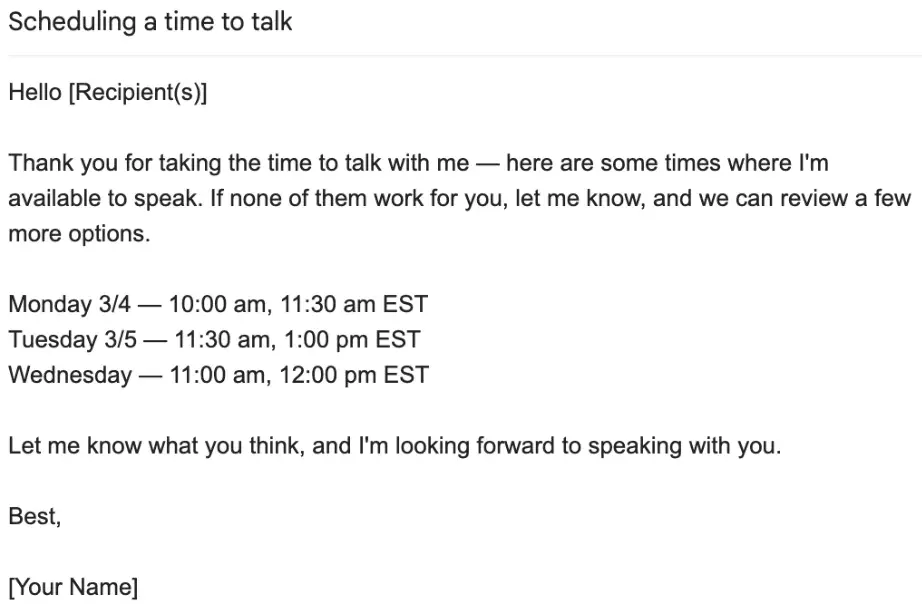
Look at that — concise, straightforward, base-covering — it's everything you need it to be.
3. Leverage a meeting poll resource.
This one kind of falls under the first tip on this list's umbrella. A lot of meeting scheduling resources include this feature. Check out this screenshot from Doodle to see what this can look like:

This kind of poll is one of the more straightforward ways to get multiple stakeholders on the same page. It offers all of the personal agency of asking, “Hey pal, what time works for you?” and with the standardization and accessibility you need to avoid feeling like you're herding cats.
4. Find common free time on Google Calendar.
I‘m going to be real — I’ve been sitting here for about 20 minutes trying to come up with a joke referencing “Blank Space” by Taylor Swift in reference to finding a “blank space” in someone‘s Google calendar for a meeting. I want to show how "with the times" and hilarious I am, but I’m not doing too hot, so I‘m giving up. I’m sorry I let you down.
But seriously, finding room in your fellow stakeholders' Google calendars is one of the better ways to schedule a meeting time that works for everyone — this method works especially well for internal meetings at businesses that leverage the GSuite.
Want to know what that might look like? Check out this hastily thrown together graphic I just made:
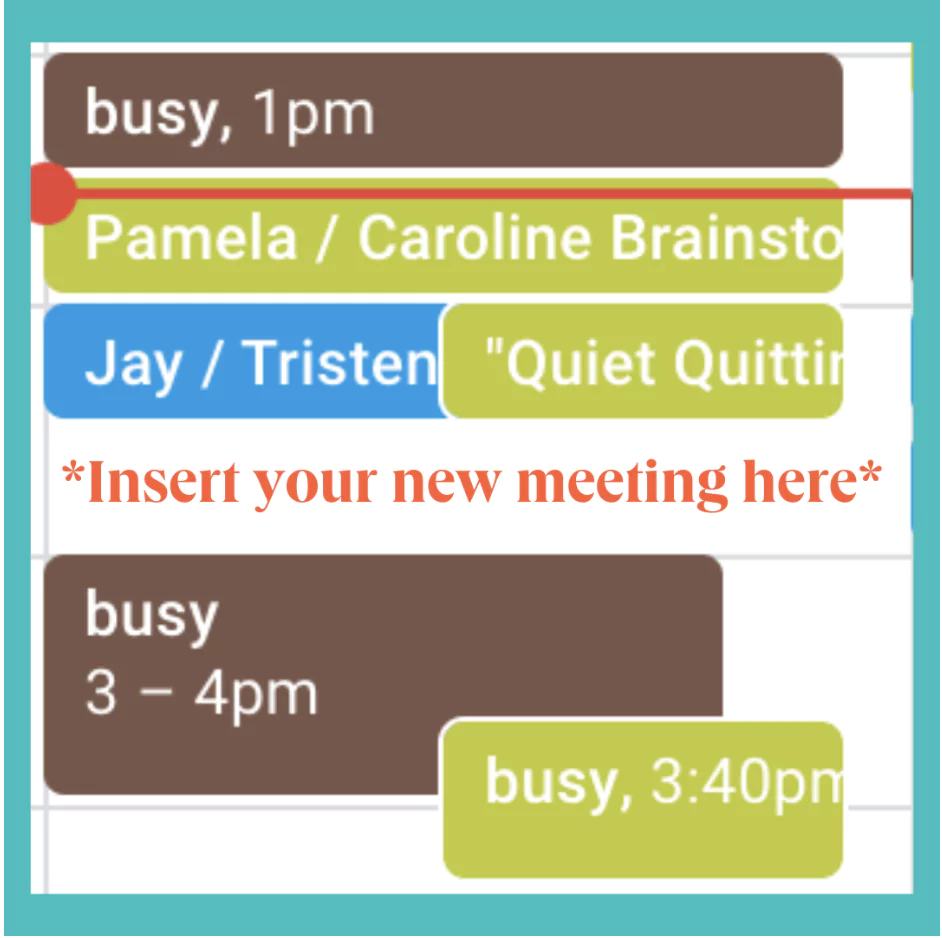
For a more thorough look at how to execute on this process, click this link to skip ahead.
5. Record a meeting or aysnc video, and send it to stakeholders who couldn't make it.
If you‘re running a meeting that doesn’t really require a ton of back and forth, brainstorming, or conversation, you can probably convey what you need to get across in a recording.
Leveraging recording functions in video conferencing apps or dedicated async video platforms like Loom can help you get everyone on the same page on their own time.
Here's what that can look like:

6. Book a recurring meeting time.
Booking a recurring meeting is one of the better ways to ensure that you establish and maintain a meeting time that works for you and stakeholders on a given team or project. Setting aside time to meet on a weekly, biweekly, monthly, or any other “-ly” basis allows you to get ahead of potential scheduling conflicts and keep everyone on the same page.
Tips for Finding a Meeting Time That Works for Everyone
- Provide meeting details.
- Prepare an agenda.
- Communicate value.
- Determine the meeting type.
- Consider all time zones.
- Schedule the meeting in advance.
- Block off 'no meeting' time on your calendar.
- Don't schedule a meeting when an email will do.
It can be a challenge to schedule meetings at times that work for everyone. Here are a few tips to keep in mind when scheduling meetings and sending meeting invitations:
1. Provide meeting details.
You want to provide some key points to your meeting attendees ahead of the meeting itself — nobody likes that weird moment where everyone spends the first couple of minutes figuring out who organized the meeting, its purpose, and what its agenda is.
Offering a quick objective statement in the meeting invitation lets you avoid all that awkwardness and get things in motion as quickly as possible. Something as simple and straightforward as including a statement like, “During this meeting, we're going to cover key adjustments in our tech stack we're making in Q1 — specifically our new CRM and conversation intelligence platform,” can ensure that your meeting starts off on the right foot.

HubSpot's Free Meeting Scheduler
Schedule meetings faster and forget the back-and-forth emails. Your calendar stays full, and you stay productive.
-
Let prospects book a meeting time
-
Book more meetings and appointments
-
Sync with Google and Office 365 Calendar
-
And more!
2. Prepare an agenda.
13-time World Series champion Yogi Berra once said, “If you don’t know where you're going, you’ll end up someplace else.” Those were some wise words, but that actually wasn't the full quote.
He really said, “If you don’t know where you are going, you’ll end up someplace else … especially during business meetings with both internal and external stakeholders — that's why you always need to set an agenda. I'm Yogi Berra. Quote me.”
Sage wisdom from an absolute legend — and he had a point. Having a set series of points you need to address to structure your meeting around helps keep things streamlined and productive.
We all know tangents happen, but you need a framework that allows you to bring things back on topic when the conversation really starts to go off the rails. It‘s the best way to respect everyone’s time, avoid irrelevant talking points, and remind everyone of the most pressing matters at hand.
Every meeting should have a purpose, and a thoughtfully constructed agenda is the best way to clearly outline what that looks like. Agendas also let you dictate the preferred pace of your meeting — you can allocate certain amounts of time for specific action items, ensuring that things stay buttoned-up and timely.
3. Communicate value.
Every meeting you schedule needs to have a bonafide, valuable purpose — otherwise you‘re just wasting everyone’s time. Before trying to schedule a meeting, always ask, “What will the other stakeholders get out of this?”
If the answer isn‘t anything of substance, the meeting can probably be an email. You need to know what the meeting’s value add is and be able to communicate it before getting everyone together.
Maybe, you want to reveal a new process. Maybe, you need to hash out the details of a new strategy to remedy a pressing issue. Maybe, you want to get everyone together to greet a new team member.
Regardless of what the “why” behind a meeting might be, make sure it‘s actually worth everyone’s time. You don't want to wind up being the boy who cried, “necessary meeting.”
If you wind up being that colleague, you'll frustrate your fellow stakeholders and potentially undermine your standing with them.
4. Determine the meeting type.
Will the meeting be a conference call, a video chat, or in-person? Having this information determined before the invites hit inboxes will save everyone a lot of time and help the meeting run smoothly. Be sure to include a link to the video or audio conference beforehand so everyone can join on time.
If you're using Google Calendar, you can easily add a video link to the meeting by pressing the button that says “Add Google Meet video conferencing.” You can also integrate other video calling platforms, such as Zoom and Microsoft Teams, to your Google Calendar.
If you're having an in-person meeting, be sure the conference room is booked and communicated to the group in advance.
5. Consider all time zones.
For a national or a global team, you'll need to keep in mind the different time zones that all meeting participants work in. You can easily see this using Google Calendar. Slack also lets you see the current time where another team member is. Personally, I love using this time zone converter tool because you're able to view multiple time zones at once and find the best time that works for everyone.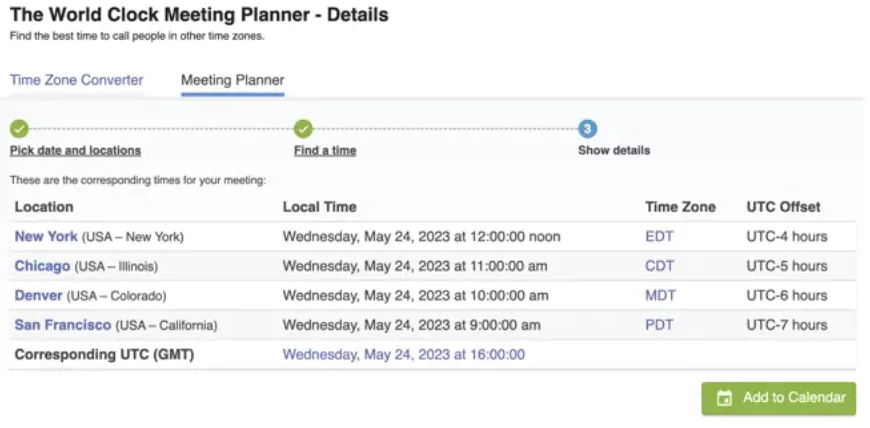 Image Source
Image Source
6. Schedule the meeting in advance.
Fun fact: Exactly zero people on planet Earth like being notified of a meeting without enough time to prepare for or plan around it — so naturally, you always want to give your fellow stakeholders some advance notice.
That‘s not just for their benefit — if you give meeting attendees a little preparation time, they’ll likely be in a better position to make more meaningful contributions to any discussion and ask more thoughtful questions.
So try to keep a solid buffer between the invitation and the meeting itself — and pass along an agenda ahead of time if you have one prepared. If everyone has a sense of what they're going to be discussing with enough time to think things through, you can keep your meetings positive and productive.
7. Block off “no meeting” time on your calendar.
If you‘re the one getting invited to a ton of meetings, you’ll find it helpful to block time off of your calendar where meetings can‘t be scheduled. Perhaps this is the time when you’re most productive, have personal activities planned, or just want to avoid being stuck in meetings all day.
Some organizations even have weekly no-meeting days in order to give their employees uninterrupted focus time and reduce fatigue. For example, HubSpot has “No Internal Meeting Fridays” in order to combat burnout. Whatever the reason, you‘ll have peace of mind knowing that your pre-planned activities and tasks won’t be interrupted by a meeting.
8. Don't schedule a meeting when an email will do.
How many times have you heard that a meeting could‘ve been an email? While this might seem like tongue-in-cheek advice, there’s some merit to the idea. If you can, send an email update instead of bringing an entire group together for an hour.
If you need to demonstrate ideas visually, consider recording a video and sending it along with your email summary. Tools like Loom make this easy and fast so you and your colleagues can get back to your day.
Luckily, there are meeting scheduling tools to simplify the process of finding the perfect meeting time.
Tools to Find a Time to Meet
- HubSpot Meetings Tool
- Doodle
- NeedToMeet
- Airgram
- SurveyMonkey
- Calendly
1. HubSpot Meetings Tool
Price: Free
The HubSpot Meetings Tool allows you to connect your Google Calendar or Office 365 calendar which automatically syncs your availability. Then you'll create a meeting link, send it to your meeting invitees, and they can choose a meeting time that works best for them.
Plus, sales teams can add their group availability or use the round-robin feature to book meetings with prospects.
Start using HubSpot's Meeting Tool
The meetings tool integrates directly with the free CRM to manage contact details and see who has booked a meeting with you.

HubSpot's Free Meeting Scheduler
Schedule meetings faster and forget the back-and-forth emails. Your calendar stays full, and you stay productive.
-
Let prospects book a meeting time
-
Book more meetings and appointments
-
Sync with Google and Office 365 Calendar
-
And more!
2. Doodle
Price: $4.08/month for 1 user (Private), $5.75/month for 1 user (Small Business), $2.98/month/user for 5 users (Business)
Doodle is a polling tool designed specifically for finding meeting times. The host of the meeting suggests possible times for the meetings and sends the poll to the meeting participants. From there, they'll enter their availability, and the meeting host selects the best meeting date and time based on the responses.
Doodle also has booking pages that allow you to send your availability to clients and have them book time on your calendar based on your shared availability. This feature also allows you to limit the amount of meetings that people can add to your calendar, block off times you don't want booked, and send out meeting reminders to prevent no-shows.

3. NeedToMeet
Price: Free (Standard), $12/year/user (Advanced), $19/year/user (Premium)
Find a time to meet by entering your meeting details, suggesting meeting dates and times based on your availability, and inviting meeting attendees. The invitees have the ability to choose from the suggested meeting dates and times and choose the one that works best for them.
NeedToMeet allows you to create custom URLs for each meeting, view attendee comments in one place, and receive email notifications when an attendee responds to your meeting invitation.

4. Airgram
Price: Free
Airgram is originally an AI-powered meeting management tool that can record, transcribe, and summarize your meetings; now it extends its capability to meeting scheduling, thus streamlining your whole meeting workflow.
This scheduling tool will connect to Google Calendar or Outlook Calendar to sync your availability. Once the calendar is connected, users can set available hours and send the scheduling link to the other person so they can choose a date and time that works.
Currently, Airgram allows users to create multiple booking pages for free. Nevertheless, this tool is best for one-on-one scheduling as it doesn't have group polling features.
5. SurveyMonkey
Price: $28/user/month (Team Advantage), $89/user/month (Team Premier), Contact for details (Enterprise)
With SurveyMonkey, you can choose a meeting date and time, create a poll, and send the link to the poll to meeting participants via email. The poll can also be embedded on a website or Facebook page to reach even more people. If they don't respond to the poll within a certain timeframe, SurveyMonkey will send a reminder email.
Not only can SurveyMonkey help you find the right time for a 1:1 meeting, but it can also help you plan out team schedules. For instance, if you manage a large team with multiple shifts, creating a scheduling poll can help you view everyone's availability all in one place.

6. Calendly
Price: Free (Basic), $8/user/month (Premium), $12/user/month (Pro)
Calendly is a meeting scheduling tool that connects to your calendar. It even lets you set your availability and send a meeting link to contacts. Meeting invitees can book a meeting at a time that's convenient for them and that time is automatically scheduled on your calendar.
Calendly's meeting poll feature helps you find the best time for team meetings. Plus, the workflows feature allows you to automate routine communications, like event reminders and follow-up meetings.
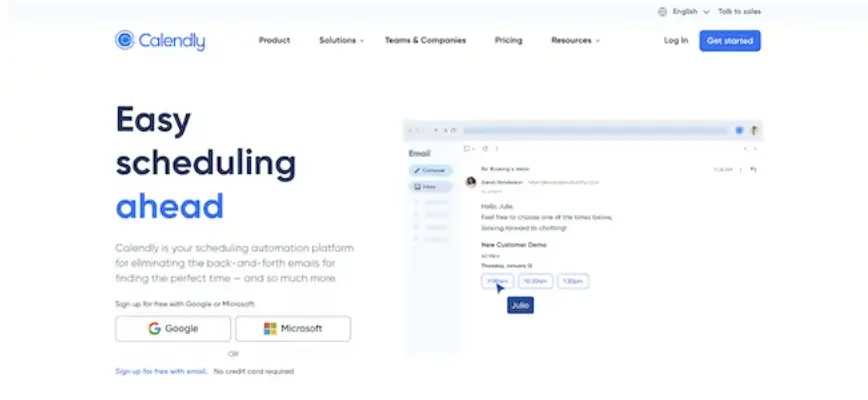
Find a Meeting Time with Google Calendar
Want to meet with one person or multiple people? You can find a time that works for everyone using Google Calendar.
1. Navigate to Google Calendar.
Start out by logging into your Google Calendar account.
.webp)
2. Create a new event or edit an existing event.
To create a new event, click “Create” and a pop-up will appear. Then click the “More options” button to add your meeting details.
To edit an existing event, click on the event you want to update, and select the pencil icon to edit it.

3. Add guests to the invite.
Add guests by searching for their email address in the “Add guests” search box.

4. Click the “Find a Time” tab.
Click the “Find a Time” tab to determine times that work best for you and your meeting guests. You can switch between a “Day” and a “Week” grid view to see which dates and times your meeting participants are available to meet.

5. Select a time.
Click the area within the calendar grid view to select a time. Press the “Save” button and the date and time will be updated.
.webp)
Once you‘ve scheduled your meeting, it’s time to refresh your memory on how to lead memories that are effective and enjoyable.
Schedule Meetings Hassle-Free
Scheduling meetings at the right time can be a struggle. But these tips and tools will make it easier to find a meeting time that works for everyone. Remember to stay mindful of everyone‘s time, offer an objective and agenda for the meeting, and when in doubt — don’t schedule a meeting that could be an email. Your calendar and your constituents will thank you for it.
Editor's note: This post was originally published in April 2020 and has been updated for comprehensiveness.



